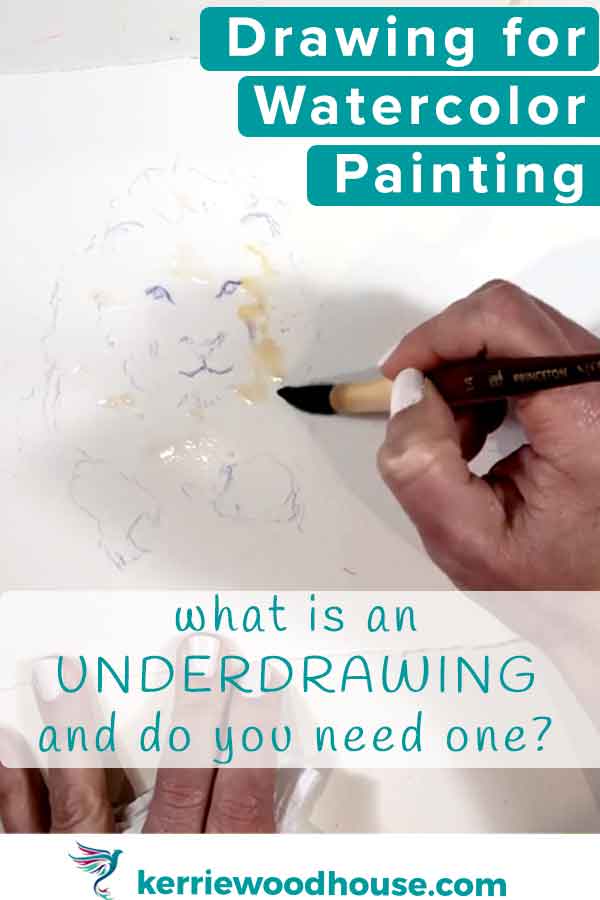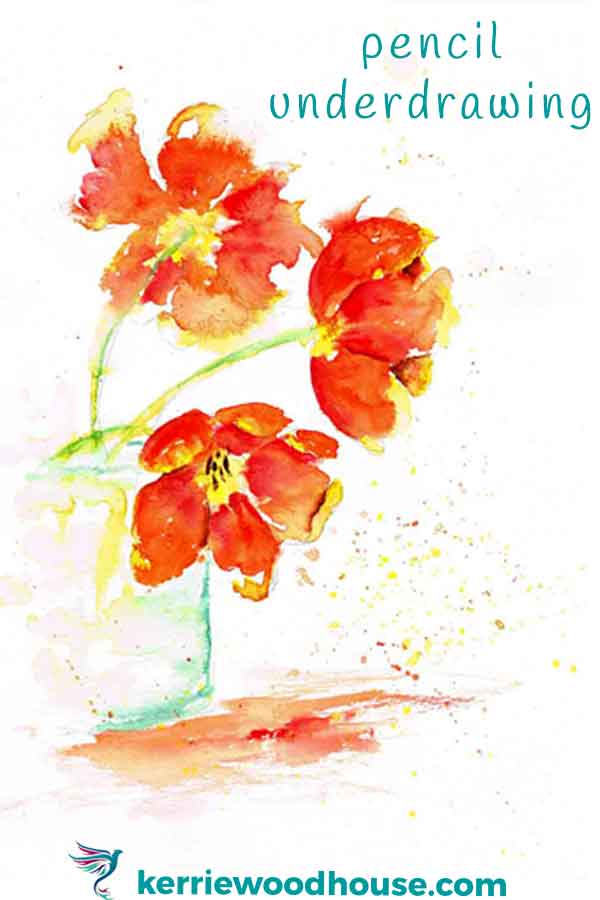Drawing for watercolor painting - what is an underdrawing and do you need one?
Disclosure: This post may contain affiliate links. That means if you buy something we may possibly get a small commission at no extra cost to you.
What is an underdrawing?
An underdrawing is the preparatory drawing on your watercolor paper that begins the painting process. This initial drawing places your subject on the page and defines where all the elements of the painting are going to be.
Ok, so what is a preparatory drawing then?
To my mind, an underdrawing is a type of preparatory drawing, but not the only kind.
Any drawing or sketching of your intended painting subject, prior to beginning the actual painting might also be described as preparatory drawing.
This is a good idea, and there are lots of different ways to go about it.
For example, you could just draw out a few thumbnails, by which I mean make little squares or rectangles in roughly the same proportion and orientation as your intended painting. Do this in a sketchbook or on any loose paper you might have to hand - copier paper is fine.
I keep these very small - maybe only a couple of inches wide. Then you can sketch out the main shapes of your subject.
Important things can be figured out at this stage, such as composition. You could try a few versions of your painting moving elements around in the thumbnails. Better to figure out that the big tree should be a little further over in a tiny thumbnail sketch than at the end of your lovely painting.
Would it look better in portrait rather than landscape, or cropped to a square?
Try it out in a few thumbnails and see!
Value is another important thing that you can think about while completing preparatory thumbnail sketches. Identifying the darkest darks and lightest lights in your paintings will go a long way to making your final artwork successful. These value thumbnails are sometimes called Notan sketches.
If you prefer, you can get out your sketchbook and do a little drawing or painted sketch of your final painting, or even just certain elements. This will make you feel much more confident when it comes to painting those parts of your final painting.
Can you do too much preparatory sketching?
Now preparation is a good thing, but I always feel that there is a delicate balance to strike. Too much preparation can be paralysing and heap too much pressure on your final artwork. The most important thing is to paint, so if in doubt jump in and do just that!
Only do the preparatory work that helps you.
Cease immediately if it stops feeling fun or prevents you from getting on with the actual painting.
Can you use watercolour paint on drawing paper?
Perhaps you are thinking that if you have got this nice drawing done you could just paint the drawing with watercolour paint?
Hmmm, sadly not - drawing paper will not handle the watercolor paint well and you will be disappointed to find a soggy mess. In fact - I think that good paper is the most critical of all supplies when if comes to watercolor painting. This post will tell you more about the best watercolour paper for your painting.
Do you need an underdrawing to begin your watercolor painting?
No - you don’t need an underdrawing.
It is quite possible to paint directly onto the clean watercolor paper. This does take a dash of boldness. Even for a reasonably experienced artist there is still something fairly terrifying about the blank page. So you don’t need an underdrawing but you might want one.
In this case, there are a few options for how detailed you may wish to make this phase of the painting process. We'll get to that in a minute.
It’s also worth mentioning that this is much easier to do once you are familiar with your subject. I painted this tulip painting with a pencil underdrawing. The pencil drawing was light and loose with minimal details because that is my preferred style. The pencil lines are visible here and there in the finished painting.
I painted this tulip painting with a pencil underdrawing. The pencil drawing was light and loose with minimal details because that is my preferred style. The pencil lines are visible here and there in the finished painting.
Then I had another go at the same subject, but this time with no underdrawing. Since I had already drawn and painted the subject once before this was a bit more of a manageable task.
These tulips were painted directly, with no underdrawing. Since I had already drawn and painted the subject once before this was a bit more of a manageable task.
What do you use to make the underdrawing?
The most common tool for drawing the sketch for your watercolor painting is a pencil. You do want something erasable when you are starting out. This means that you can make small adjustments to your underdrawing in the early stages.
It does require a bit of care however, since erasing on your watercolor paper does risk damaging the surface of the paper. There are some watercolour artists who would never dream of sullying the pristine page with erasings. The alternative for these artists might be to complete the drawing on a sheet of ordinary drawing paper and then transferring it cleanly to the watercolour paper.
How you ask?... This post offers some suggestions.
I am firmly in Camp Cavalier and don’t hesitate to draw on my watercolor paper. It is a matter of style and personal preference. I paint in a loose expressive style, and I paint for the love of it so beginning with a cautious (IMO tedious) drawing process does not suit me at all.
If you choose to walk on the wild side with me and draw onto your watercolor paper directly the best approach is to draw very lightly and be sure that you are equipped with a very good gentle but effective eraser - I prefer a kneaded or gum eraser (like this one).
If you use a pencil that is too hard, and too sharp you can end up indenting grooves on your watercolour paper. When you apply paint to these areas it will sink into the groove making a very dark line that you will be unlikely to be able to hide.
If you use a pencil that is too soft it will be very likely to smudge. I don’t like that at all. I like pure bright colours so I hate the idea of smudgy grey graphite dulling them down.
My preferred alternative is an erasable coloured pencil. I used to use the Prismacolour ones but more recently moved to the pilot clutch version which I love. These coloured pencils do erase, but not as cleanly as graphite pencil might.
You are going to have to experiment and see what works for you.
Does pencil erase under watercolour?
One word of warning is in order here to be fair - once you cover pencil with watercolour you will not be able to erase it. Since watercolour is transparent you will also be able to see the mark unless it is a very pale sketch mark and a dark watercolour paint.
For many artists, the pencil sketch is a part of the painting and the visible pencil marks are an important part of the whole. Again, the choice is yours. How great is that?
Just remember that if your choice is not to see the pencil marks then you need to erase any of them that you feel will not be covered by the painting - before you start painting!
Can you make a pen underdrawing for watercolour painting?
You could take the visible underdrawing a step further and use a pen.
This is a technique often referred to as ‘ink and wash’ or ‘line and wash’ and it is a popular style of its own. I enjoy working this way in my sketchbook because the paper in a sketchbook is never quite as good as watercolour sheets or pads. I think the ink seems to make up for any shortcomings in the paint effects resulting from the paper performance.
This sketchbook painting of a bicycle makes a virtue of the underdrawing by using pen. The pen details do a good part of the work and make up for any underperformance of the paper in the sketchbook.
How detailed does the underdrawing need to be?
As I mentioned earlier you have options here.
No sketch
Paint directly on the paper. In this video you can see me painting a bunch of grapes (something I have painted a few times before). I am painting with no sketch directly onto clean watercolour paper.
Detailed underdrawing
The other extreme is to do a very detailed drawing on drawing paper transferred cleanly to the paper. This will likely mean that your painting is more like a colouring exercise where the watercolour paint is the colouring medium for your detailed line drawing.
You might also achieve this just by drawing lightly but directly on the watercolour paper, usually with the intention of having the underdrawing show through your painting.
Loose underdrawing
This is my preferred option. If you are wanting to paint in a loose style, then I think a loose underdrawing is the way to begin. I find it is very difficult to achieve a loose expressive watercolor painting if you begin with a tight and detailed drawing.
I like to create a very loose sketch with minimal lines directly on my watercolor paper. All I am aiming to do is give myself a guide as to where to place the main parts of my painting. Sometimes I will do some preparatory sketches in my sketchbook or on loose copier paper if I am trying to figure things out.
Over the years I have collected quite a few useful tips that really helped me feel confident about drawing. I put them all in my most comprehensive course - the one that teaches you how to draw anything you want AND paint it joyfully, in loose expressive watercolour.
This playlist from my World Watercolour Month series will show you my process across many different subjects.













Being able to add perspective to your drawings instantly adds a touch of realism and invites the viewer into your picture. But when you are starting out, learning about perspective can seem terribly daunting.
Here are 7 things you need to know about drawing in perspective that might help.